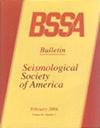A New Paradigm for Structural Characterization, including Rotational Measurements at a Single Site
IF 2.9
3区 地球科学
Q2 GEOCHEMISTRY & GEOPHYSICS
引用次数: 0
Abstract
In this article, we demonstrate that a single station can be used to measure the dynamic properties of a structure. The station includes a collocated accelerometer and rotational sensor, hence, can record both three-component translation and three-component rotation and is referred to as the 6C-station within this study. The key advantage of this approach is to provide a fast and simple path to a comprehensive structural health monitoring characterization that is comparable to the use of a traditional approach using a horizontal array of three-component accelerometers. The deployment of newly developed high-quality rotational sensors allows the direct measurement of structural rotations, facilitating the extraction of structural mode shapes. In this work, we show how an established system identification tool, stochastic subspace identification, can be applied to the 6C-station data and characterize modal properties and structural response. Our results are verified and contrasted against standard horizontal and vertical array configurations. The Prime Tower, a high-rise structure in Zürich, serves as a case study. A structural characterization of this building is presented for the first time. We show that a 6C-station is capable of defining the frequencies of this stiff high-rise building with a fidelity that is on par with a five-sensor horizontal array. The mode shapes of the roof can be precisely determined with a confidence margin that is comparable to conventional sensing array solutions. However, the effectiveness of using only a 6C-station is determined by the noise level of the sensors—in particular, the rotational seismometer needs to be of high quality. The results indicate that, owing to the collocation measurement of translation and rotation, a 6C-station can deliver a comprehensive structural monitoring solution with minimum time, effort, and footprint.结构表征的新范式,包括单个位点的旋转测量
在这篇文章中,我们证明了一个单站可以用来测量结构的动力特性。该台站包括一个加速度计和旋转传感器,因此可以同时记录三分量平移和三分量旋转,在本研究中称为6c台站。该方法的主要优点是提供了一种快速、简单的方法来进行全面的结构健康监测表征,这与使用三分量加速度计水平阵列的传统方法相当。新开发的高质量旋转传感器的部署允许直接测量结构旋转,便于提取结构模态振型。在这项工作中,我们展示了如何建立一个系统识别工具,随机子空间识别,可以应用于6c站数据和表征模态特性和结构响应。我们的结果经过验证,并与标准的水平和垂直阵列配置进行了对比。位于z rich的高层建筑Prime Tower就是一个研究案例。该建筑的结构特征首次呈现。我们展示了一个6c基站能够确定这个僵硬的高层建筑的频率,其保真度与五个传感器水平阵列相当。屋顶的模态振型可以精确地确定,其置信度与传统传感阵列解决方案相当。然而,仅使用6c台站的有效性取决于传感器的噪声水平,特别是旋转地震仪需要高质量。结果表明,由于平移和旋转的搭配测量,6c站可以以最小的时间、精力和占地面积提供全面的结构监测解决方案。
本文章由计算机程序翻译,如有差异,请以英文原文为准。
求助全文
约1分钟内获得全文
求助全文
来源期刊

Bulletin of the Seismological Society of America
地学-地球化学与地球物理
CiteScore
5.80
自引率
13.30%
发文量
140
审稿时长
3 months
期刊介绍:
The Bulletin of the Seismological Society of America, commonly referred to as BSSA, (ISSN 0037-1106) is the premier journal of advanced research in earthquake seismology and related disciplines. It first appeared in 1911 and became a bimonthly in 1963. Each issue is composed of scientific papers on the various aspects of seismology, including investigation of specific earthquakes, theoretical and observational studies of seismic waves, inverse methods for determining the structure of the Earth or the dynamics of the earthquake source, seismometry, earthquake hazard and risk estimation, seismotectonics, and earthquake engineering. Special issues focus on important earthquakes or rapidly changing topics in seismology. BSSA is published by the Seismological Society of America.
 求助内容:
求助内容: 应助结果提醒方式:
应助结果提醒方式:


